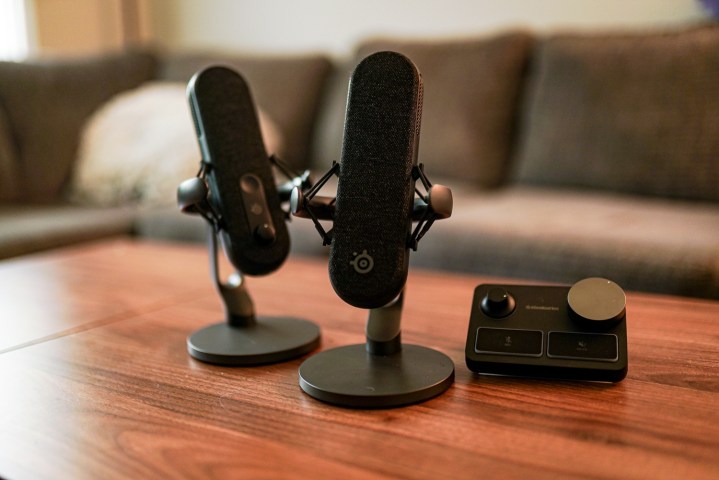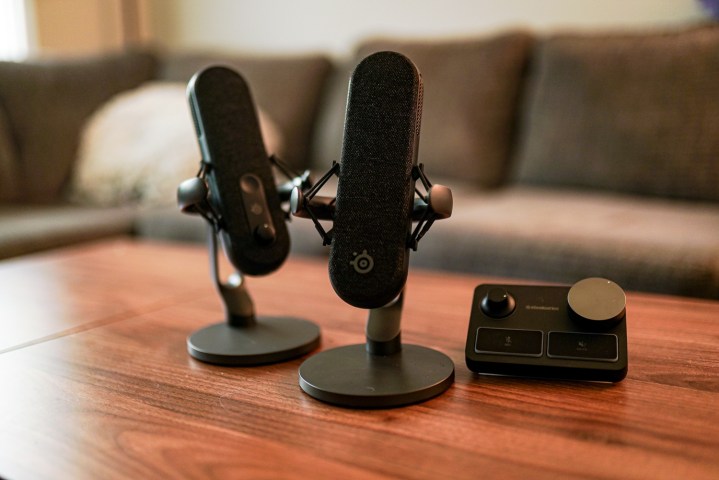
I thought I had my audio figured out. Before I started reviewing graphics cards and gaming monitors, I worked at a recording studio, and got my foot into the world of reviewing with pro audio equipment. I’ve touched microphones that you could find in a bargain bin for $50, and microphones that cost more than a car. SteelSeries’ new Alias and Alias Pro are something different.
They don’t sound better than those microphones that cost thousands of dollars — not even close — but they’re far and above what I’ve seen out of USB microphones. After using them for a bit, it’s clear they’re even better than my current audio setup, which is comprised of a Shure SM7B (the gold standard for broadcast microphones) and a GoXLR Mini.
Not only are they better, but the SteelSeries Alias Pro is also only about half the price of that setup, and the base Alias is about a quarter of the price. The Alias and Alias Pro are still expensive at $180 and $330, respectively, but they look like a downright deal compared to the next step up in the world of audio equipment.
Before getting much further, though, it’s worth comparing the three. I’d suggest listening to the below comparison with high-quality headphones to make out the difference. The Shure is definitely brighter, but the two Alias models have far more body to them. These were recorded in a large room without any carpeting or sound-dampening material, and were positioned about four inches away from my face.
The Alias and Alias Pro will sound largely similar assuming you’re at least reasonably close to the mic. The Shure is a different story. It’s a dynamic microphone, while the two Alias models are condensers. Dynamic microphones are prone to the proximity effect. That is, as you get closer to the microphone, it will pick up for low-end frequencies. That can be a positive, if you want to get extremely close to your microphone for the best sound, but it’s not ideal if you don’t like constantly adjusting your mic arm.
Condensers are far more forgiving. You’ll see them, rather than dynamic microphones, used to record vocals in most cases, with some vocalists standing multiple feet away from the mic. The Alias and Alias Pro fall into that camp, though they are also far more sensitive to noise. There’s a handy AI-powered noise cancellation feature that I’ll dig into shortly that can help, thankfully.

The big plus side of condensers is that they require 48-volt Phantom Power, providing a much hotter signal out of the gate. Dynamic microphones, which can be used to mic things like a drum kit or blistering guitar cabinet, are quieter coming in. This is particularly a problem for the Shure SM7B, as you’ll need to invest in something like the $150 Cloudlifter to get a decent signal. I’ve had way too many Discord and Teams calls where I get the “you’re too quiet” comment despite everything being cranked up on my Shure.
That’s not an issue with the Alias Pro, which is the true competitor to my Shure setup with its XLR connection and external preamp. Its closest competitor is the Logitech Blue Sona, which is a dynamic microphone with a gain-boosting preamp built in. However, it uses an XLR connection, meaning you’ll need an external solution for connecting it to your PC.
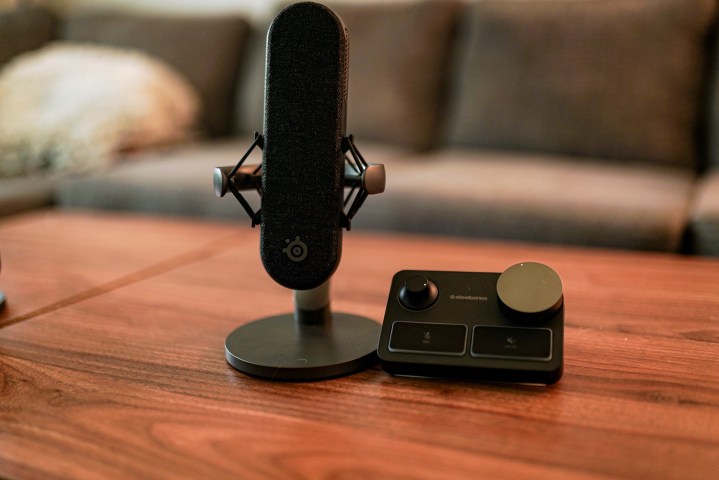
That’s one of the most attractive aspects of the Alias Pro. It comes with the interface you need. For any other XLR microphone, you’ll need to pick up something like the GoXLR Mini, Elgato Wave XLR, or a standard audio interface like the Focusrite Scarlett 2i2. Regardless, you’re adding anywhere from $100 to $400 on top of the cost of the microphone just to hook it up to your PC.
The Alias Pro’s preamp isn’t just a connection interface, though. It includes a large gain and volume dial, along with dedicated microphone and speaker mute buttons. The secret sauce comes in the back, though. The Alias Pro offers two USB ports so you can connect the microphone to multiple PCs. That gets around a ton of headaches if you have a dual PC streaming setup.
I’ll admit, the GoXLR Mini and devices like the Razer Audio Mixer provide dedicated sliders for multiple channels of audio, and I much prefer that setup for quickly adjusting the audio of a game, Discord chat, and music streaming app. Given how much cheaper the Alias Pro package is, though, it’s a fair trade-off to make.
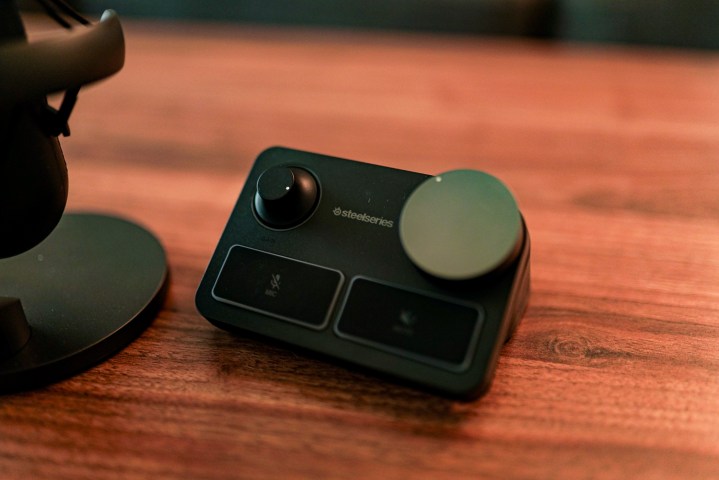
I’ve focused mainly on the hardware here, but a major component of the Alias and Alias Pro is the software. Bringing this audio solution together is SteelSeries Sonar, as well as the revamped Sonar for Streamers. SteelSeries debuted this app with the launch of the Arctis Nova Pro headset, and it remains one of the most powerful software audio solutions available.
A big part of that is routing. You can have up to five audio channels that will show up as separate channels in Windows. You can have Spotify on one, Discord on another, your game on a third, and so on — and manually adjust the volume of each in one app. Sonar for Streamers takes this a step further and allows you to maintain a personal mix and a stream mix. Maybe you want music in your ears, but not going out to your stream, for example.
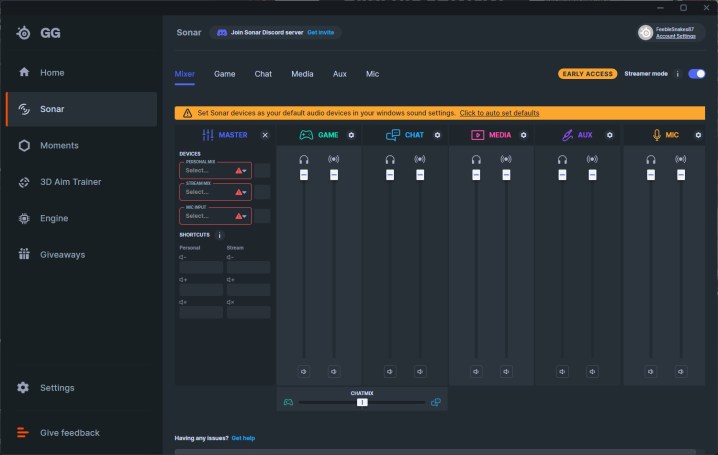
SteelSeries Sonar is far more powerful than just routing, too. Each channel also comes with its own EQ, equipped with SteelSeries’ presets or your own custom curve. There are 72 games with dedicated EQ curves, many of which are made by the developers themselves. The Diablo IV curve comes from Blizzard, the Destiny 2 curve comes from Bungie, and the Rainbow Six Siege curve comes from Ubisoft. I’ve used probably a dozen of them, and they all sound great.
There are some additional options for outputs, such as spatial audio and dynamic volume adjustment, but the more interesting settings are in the microphone section. You get an EQ, but also Clearcast AI noise reduction, a noise gate, and (this is the big one) a compressor. A good compressor makes all the difference in making your microphone sound broadcast ready, and the single slider available in Sonar gives you a taste of that without forcing you to learn how to actually use a compressor.
Just a few years ago, connecting a broadcast microphone to a PC with any reasonable quality was something that would cost you above $500, and easily close to $1,000. For a lot of setups, you still need to spend that much. The SteelSeries Alias Pro solves that for significantly less, all while being backed up by world-class software.
Even if you don’t have the cash to spare, the good news is that SteelSeries Sonar is free, and it works with any speakers and microphone. I’ve even been using it with my Shure setup. If you’re looking for a microphone upgrade, however, pairing Sonar with the Alias Pro is definitely the way to go.
Editors’ Recommendations
Services Marketplace – Listings, Bookings & Reviews
